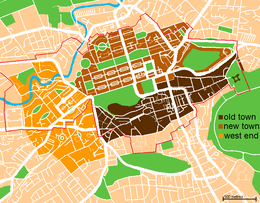The Canongate
The Canongate is a street and associated district in central Edinburgh, the capital city of Scotland. The street forms the main eastern length of the Royal Mile while the district is the main eastern section of Edinburgh's Old Town. It began when David I of Scotland, by the Great Charter of Holyrood Abbey c.1143, authorised the Abbey to found a burgh separate from Edinburgh between the Abbey and Edinburgh. The burgh of Canongate that developed was controlled by the Abbey until the Scottish Reformation when it came under secular control. In 1636 the adjacent city of Edinburgh bought the feudal superiority of the Canongate but it remained a semi-autonomous burgh under its own administration of bailies chosen by Edinburgh magistrates, until its formal incorporation into the city in 1856.
The burgh gained its name from the route that the canons of Holyrood Abbey took to Edinburgh - the canons' way or the canons' gait, from the Scots word gait meaning "way". In more modern times, the eastern end is sometimes referred to as part of the Holyrood area of the city.
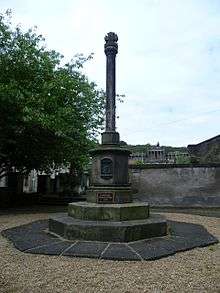
The Canongate contains several historic buildings including Queensberry House, now incorporated in the Scottish Parliament Building complex, Huntly House (now the Museum of Edinburgh), the Canongate Tolbooth (now housing the People's Story Museum) and the Canongate Kirk, opened in 1691 replacing Holyrood Abbey as the parish church of the Canongate. The church is still used for Sunday services as well as weekday concerts.
Early history
The Canongate owes its existence to the establishment of Holyrood Abbey in 1128. King David I, who established the Abbey, gave the surrounding area to the Augustinian canons then resident at Edinburgh Castle in the form of a regality.[1] The King also gave leave to the canons to establish a burgh between the abbey and Edinburgh, and as it was the only burgh within the regality it was given the status of burgh of regality of Canongate.[1][2] The area originally controlled by the abbey included the lands of Broughton, areas around the Pleasance and North Leith, giving the canons access to a port.[3]
Holyrood Palace was developed from the 14th century onwards as successive monarchs made increasing use of the Abbey for political events such as parliaments and royal councils. The word "Pallais" appears in a reference to the royal lodgings in the reign of James IV, but they were first converted to palace buildings by James V in 1525.[4]
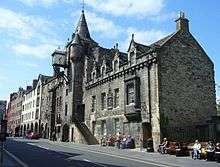
The burgh of Canongate had a sometimes turbulent relationship with its neighbour, Edinburgh. The main reason for this was the continual battle over their exact boundaries up until their unification in 1856, an event which proved unpopular with the former's townsfolk.[5]
King James VI of Scotland's accession to the throne of England in 1603 began the long and slow decline of the Canongate. The loss of the royal court from the Holyrood Palace inevitably affected the wealth of the surrounding area. This was compounded by the union of the parliaments in 1707, as up until then Edinburgh had been the location of the Parliament of Scotland with the Canongate providing a fashionable suburb for the dwellings of the political class. The North Bridge, finally opened in 1772, provided a new and more convenient route from Edinburgh to the port of Leith effectively bypassing the Canongate which had until then been the main route from Edinburgh to Leith via Easter Road causing even more neglect to the residential area which was gradually taken over by industrial premises including breweries and a large gasworks.
The Canongate was an important district during the Scottish Enlightenment partly because of the presence of the Canongate Theatre (1746-1786), of which one of the proprietors was Lord Monboddo. The philosopher David Hume performed in a play staged there.[6]
Writing in 1824, Robert Chambers said of the Canongate, "As the main avenue from the palace into the city, it has borne upon its pavements the burden of all that was beautiful, all that was gallant, all that has become historically interesting in Scotland for the last six or seven hundred years".[7]
Sir Walter Scott writing in 1827 stated; "Sic itur ad Astra; This is the path to heaven. Such is the ancient motto attached to the armorial bearings of the Canongate, and which is inscribed, with greater or less propriety, upon all the public buildings, from the church to the pillory, in the ancient quarter of Edinburgh which bears, or rather once bore, the same relation to the Good Town that Westminster does to London".[8]
Modern era
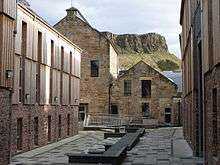
The area has seen various attempts at improvements and slum clearance, including various schemes by Ebenezer James MacRae in the 1930s and Sir Robert Hurd[9] in the 1950s in traditional style replicating original facades. Another scheme, completed in 1969, by the Basil Spence practice was in modern style but in proportion to surrounding buildings.
Due to the redevelopments of the 1950s/60s the overcrowded and impoverished area suffered from serious depopulation. From the 1960s onwards the Canongate area became notably less industrial, with all of the breweries closing. Residential redevelopment began on former industrial sites in the 1990s and 2000s with flats, offices and other commercial operations being built south of the main road, reversing the decline in population. Whilst much of this development has a modern appearance, some attempt has been made in terms of layout to retain the "fishbone" pattern characteristic of the Royal Mile.
As of 2006, the redevelopment of former industrial land to the north of the Canongate, once occupied by Victorian gasworks and a later bus garage, has proved controversial, partly due to the original proposal, now abandoned, to demolish some of the replacement buildings from the 1930s.
Above all, the construction of the new Scottish Parliament Building on the site of the old Younger's Abbey Brewery has led to a resurgence of the area's vitality with the Canongate becoming the centre of Scottish political life.
Although modern development is arguably of high quality it fails to reflect the traditional character of the area.
Education
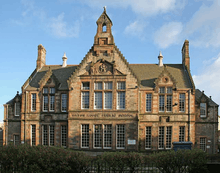
The Royal Mile Primary School, formerly known as Milton House Public School, is a non-denominational state school that provides primary education for 5- to 11-year-old children. It was designed in 1886 by Robert Wilson, architect for the Edinburgh Board of Education.[10]
Within the school, there is also a nursery which caters for 3- to 5-year-old children. As the school is so central to the Canongate community, its pupils are often involved in illustrious events at the Scottish parliament and Edinburgh Castle. It is used as a polling station for the constituents of Edinburgh Central.[11]
The Canongate is also the location of Moray House, the Education department of the University of Edinburgh[12] (formerly Moray House College of Education). It comprises a number of buildings centred on St. John Street, some of which are historic, whilst others are purpose built. A number of other university buildings including the Pleasance student union building and the Centre for Sport and Exercise are located in the area historically covered by the Canongate.[13]
Historic crosses
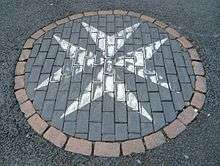
There were three crosses on the Canongate section of the Royal Mile.
The ancient Mercat Cross (Market Cross) or Burgh Cross is shown on Gordon of Rothiemay's 1647 plan as being in the middle of the road nearly opposite the tolbooth. Gordon shows it as being similar to the Edinburgh Mercat Cross with the shaft and cross mounted on a stone gallery.[14] The much-altered cross now stands in the south-east corner of Canongate Churchyard to the right hand side of the entrance to Canongate Kirk.
The St John's Cross used to stand further up the Canongate to the west.[15] The site is now marked by a maltese cross formed by coloured setts in the road surface near the top of St John's Street (55.950975°N 3.181766°W). It was known as St. John's Cross because it stood on property thought to belong to the Knights of St. John in the Middle Ages, and it marked the ancient boundary of that part of the Royalty of Edinburgh which lay outwith the Netherbow Port and the city wall.[16][17]
Where the Girth Cross, which has also been called the "Abbey" or "South" Cross at various times,[18] once stood is now marked by a radiating circle of setts. (55.95260°N 3.17492°W).[19] It marked the western limit of the Girth of Holyrood, "the greatest sanctuary in Scotland, and the last to disappear".[18] It is shown on a map of the 1573 siege of Edinburgh, published in Holinshed's Chronicles in 1577, as an ornamental shaft elevated on a flight of steps and was not demolished until after 1767. In its shadow proclamations were read and executions were carried out. A notable execution took place next to the cross in 1600 when the young and beautiful Jean Kincaid (Lady Warriston) was beheaded by the Maiden for conspiring in the murder of her abusive husband.[19]
Coat of arms
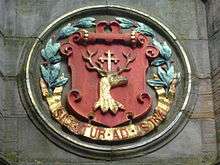
The coat of arms of the Canongate features a white hart's head and a golden cross, recalling the old legend in which King David I was saved from goring from a stag by the sudden appearance of a holy cross. The arms, though technically obsolete since the abolishment of the burgh of Canongate in 1856, can still be seen in many locations in and around the district, including on Edinburgh's mercat cross where they appear alongside the royal arms of Britain, Scotland, England and Ireland, the burgh arms of Edinburgh and Leith, and the arms of the University.
The motto is Sic itur ad astra meaning 'thus you shall go to the stars', a quote from Virgil's Aeneid.
Important buildings
- Canongate Kirk 1691.
- Moray House, 1625, extended as Moray House College of Education.
- Queensberry House, 1686, now part of the Scottish Parliament.
- Canongate Tolbooth, 1591, now the People's Story Museum.
- 167 - 169 Canongate, early 17th century, upper floors part of People's Story Museum, ground floor a public house.
- Lodge Canongate Kilwinning Number 2[20] 1736, the oldest purpose built masonic lodge still used for its original purpose, officially "Lodge no. 2" attended by Robert Burns who was Invited to become their poet laureate.
- Chessel's Court, 1745.
- Morocco Land, a tenement of 1730 bearing the carved upper torso of a Moor.
- Shoemaker's Land, a tenement of 1725.
- Bible Land, a tenement of 1677.
- Huntly House, from 1517, now the Museum of Edinburgh.
- Whitefoord House, 1769, now the home of the Scottish Veterans Association.
- White Horse Close, a picturesque courtyard dating from around 1680 which served the Edinburgh-London coach and mailcoach route in the 18th century, restored in the early 1960s.
- Golfers Land
Famous residents
- Bruce Chatwin (1940–89) lived in Canongate while a student at University of Edinburgh from 1966–68
- Oliver Cromwell stayed at Old Moray House during two periods of residence in Scotland
- John Gay stayed at Queensberry House as guest of his patron, 3rd Duke of Queensberry
- Lord Milton
- Mary Dudley, Countess of Home, builder of old Moray House.
- Very Rev Dr Patrick MacFarlan born in Canongate manse
- Christian Ker Reid, silversmith born here
- Tobias Smollett lodged briefly at his sister's house above St. John's Pend
- Adam Smith lived in Panmure Close
- Lord Monboddo, whose house stood in St. John's Street
- Sir William Wardlaw, 16th baronet lived at Chessels Court[21]
- John Nisbet, Lord Dirleton
- William Bannatyne, Lord Bannatyne lived and died in Whiteford House.
Literature
Walter Scott named Chronicles of the Canongate (1820s) after the area.
Notes
- A Treatise On The History, Law, And Privileges Of The Palace And Sanctuary Of Holyrood House
- Dennison 2005, p. 4.
- Dennison 2005, p. 6.
- J Mackay, History of the Burgh of Canongate, Edinburgh 1886, p.7
- Susan Varga: Edinburgh Old Town (2006)
- Cloyd, E.L., James Burnett, Lord Monboddo (1972)
- Hamish Coghill, Edinburgh: The Old Town (1990)
- "The Chronicles of the Canongate by Sir Walter Scott: Chapter 1".
- Buildings of Scotland: Edinburgh, by Colin McWilliam
- Buildings of Scotland, Edinburgh by Gifford McWilliam and Walker
- Royal Mile Primary School Official Website
- "Moray House School of Education - The University of Edinburgh".
- "Maps - The University of Edinburgh".
- "Bird's eye view of Edinburgh in 1647 / by James Gordon of Rothiemay". Town Plans / Views, 1580-1919. National Library of Scotland. Retrieved 26 April 2016.
- Best of Edinburgh Attractions 2006.
- Dennison 2005, p. 89.
- Royal Mile, St. John's Cross.
- Canmore 1953.
- Royal Mile, The old Girth Cross.
- "Chapel Entrance - Lodge Canongate Kilwinning No. 2".
- "(234) - Scottish Post Office Directories > Towns > Edinburgh > 1805-1834 - Post Office annual directory > 1832-1833 - Scottish Directories - National Library of Scotland".
References
- "Edinburgh, Canongate, Girth Cross", Canmore, 25 December 1953, retrieved 13 September 2015
- Dennison, E. Patrica (2005), Holyrood and Canongate: A Thousand Years of History, Edinburgh: Birlinn, p. 89
- "Edinburgh-Royal Mile St. John's Cross". Royal Mile. Retrieved 13 September 2015.
- "The old Girth Cross". Royal Mile. Retrieved 13 September 2015.
- "A Walk Down the Royal Mile: The Canongate", Best of Edinburgh Attractions, 18 November 2006, retrieved 13 September 2015
External links
| Wikimedia Commons has media related to Canongate. |
